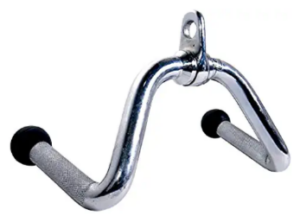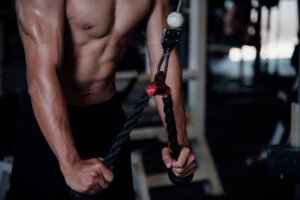
There are so many different cable attachments for weightlifting.
You may be wondering how each weightlifting cable attachment works and how they all differ from each other.
Some weightlifting cable attachments are more ergonomic (comfortable, easier on the wrist and shoulder joints) than others.
Some can be gripped multiple ways, while others offer only one gripping option.
But even the standard pull-over bar, one of the most commonly used cable attachments for weightlifting, offers variations, in that some of them slope down at either end only slightly, while others have a more dramatic slope.
Some are smooth metal all the way, while others have a rough surface at varying points for a better grip.
When the hands are gripping as far apart as possible for a pull-down, the latissimus dorsus muscle will be recruited at its best.

However, this maximally wide grip has a caveat: It can be uncomfortable at heavy loads and strain the shoulder joint.
The bar with the extra-sloping ends enables the exerciser to do very low behind-the-neck pull-downs, which are not recommended because these can over-stress the rotator cuff, not to mention throw off spinal alignment.
Another popular weightlifting cable attachment is the double V handle. It allows for more resistance to be pulled down, is very comfortable on the shoulder joint, easy to use, and works both for lat pull-overs and seated rows.
The person grips this cable attachment with both palms facing each other, then pulls down from above, or pulls towards the chest for a seated row.
If you want to buff up your forearms, this is the perfect handle, because the forearm muscles really get recruited.
The double V handle comes in a wider variety, which allows you to go deeper with the pull, since the grip is a little further apart.

But the further apart the grip, the more difficult the pull. Nevertheless, these are nifty cable attachments because the wider V handles typically have a thicker, cozier-feeling area to grip.
And then there is the e-z bar cable attachment, which offers a few places of hand positioning.

Shutterstock/BLACKDAY
This bar has several curves that allow you to pull with slightly inward wrists, thereby eliminating strain on the wrists.
This cable attachment can also be used with palms facing downward to recruit more of the forearms.
There is another type of weight lifting cable attachment that’s about as long as a standard pull-over bar, except that it has hand-grips at the end that allow your palms to face each other.

This has a few advantages over the standard bar. Heavy pull-downs, done with palms facing each other, are easier on the shoulder and elbow joints.
Secondly, if you have a thumb injury, it’s easier for the four fingers to grasp the handles when the palms are facing each other, than the standard bar with the palms facing away from the person.
Another type of weight lifting cable attachment is the single handle, often used for one-arm triceps routines.
However, two of these handles can be doubled up for a bilateral routine like cross-overs.
Doubling these up is the option for people who want to use the double V handle, but can’t find one available.
A favorite cable attachment for weight lifting is the rope.

Freepik.com jcomp
This comfortable implement is typically used for triceps routines, and can be used unilaterally in the form of triceps kickbacks.
For best weightlifting results, use a variety of cable attachments; don’t always use the same cable attachment for your strength training.











